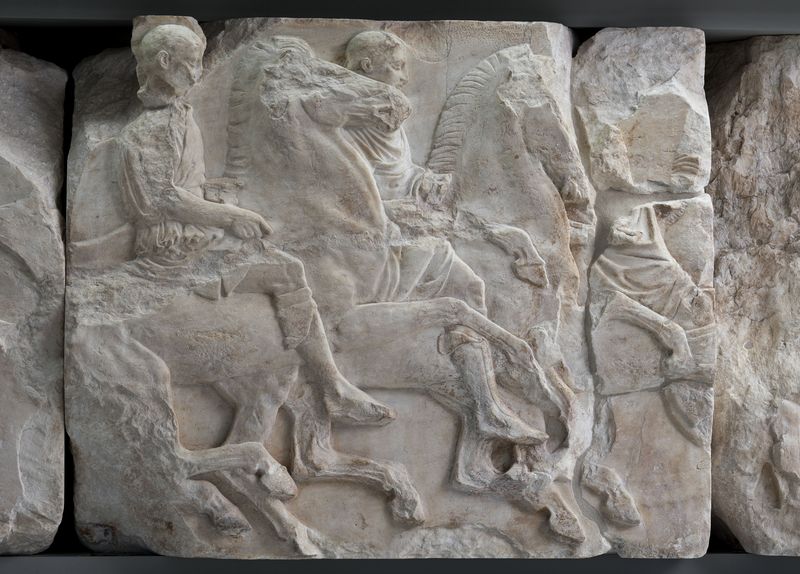Parthenon. South frieze. Block 17 (XVII)
Inventory number
Ακρ. 868
Artist
Pheidias' workshop
Category
Architectural sculpture
Period
Classical Period
Date
442-438 BC
Dimensions
Height: 1.02 m
Length: 1.22 m
Material
Marble from Penteli
Location
Parthenon Gallery
On block XVIΙ three horsemen gallop vigoursly to the right. All three are dressed in a short chiton and chlamys over it and wear embades. The last rider’s horse on the left, as well as the edge of his chlamys, continues on the next block XVI (Ακρ. 867). Part of the horse of the preceding horseman is depicted on the previous block ΧVIIΙ (Ακρ. 869). The horses' fittings were made of bronze once fixed in the holes still seen on the block.
The frieze on the south side of the Parthenon depicts part of the procession formed by the people of Athens during the Panathenaic festival in honour of Athena, the protectress of the city. The procession's destination was the Temple of Athena Polias on the Acropolis. Its purpose was the transportation of the Panathenaic peplos destined to adorn the age-old xoanon of the goddess and the offer of a grand sacrifice of animals at the Great Altar outside of the temple.
On the south frieze the procession moves along the Panathenaic Way. Youths that walk behind sacrificial young cows precede. They are followed by more young men who carry offerings. Behind them come musicians with guitars, officials holding olive branches, eleven chariots that participate in an equestrian event, and finally sixty riders divided in ten groups.
The south frieze is fragmentarily preserved due to the bombardment of the Parthenon by the Venetians under the command of the general Francesco Morosini in 1687 which caused extensive damages to the middle of the long sides of the temple. The drawings attributed to the painter Jacques Carrey, who visited the Acropolis in 1674, just thirteen years before its bombardment by Morosini, are an invaluable resource for our understanding of quite a few parts of this side of the frieze (blocks XX - XXXVIII). Three blocks (XXII, XXX και XXXVIII) were already lost by then as they were removed during the conversion of the Parthenon into a Christian church so that windows would be opened in the blocks' positions.
The initial length of the south frieze was 58.70 m and consisted of 47 blocks. Today the blocks are divided between the Acropolis Museum and the British Museum in London, where they ended up after they were removed by Thomas Bruce, the lord of Elgin, in 1801-1804 when Greece was still under Ottoman occupation. In order to facilitate their transportation, Elgin's workmen, cut off with saws or crowbars only the faces of the blocks that bore the relief decoration. The Acropolis Museum exhibition includes the plaster casts of these blocks' faces on which some of the original fragments that fell off the monument, and thus escaped the looting, have been adjusted.
Michaelis, Α., Der Parthenon, Leipzig, 1870-1871, σελ. 203-208:1-26, 232-234, 236, πίν. Χ, αρ.κατ. Platte XVΙΙ
Smith, A.H., British Museum. The Sculptures of the Parthenon, London, 1910, σελ. 63, εικ. 120, πίν. 80
Casson, S., Brooke, D., Catalogue of the Acropolis Museum. Sculpture and Architectural Fragments, with a section upon the Terracottas, II, Cambridge, 1921, σελ. 115-117, εικ. 868, αρ.κατ. 868
Schuchhardt, W.H., «Die Entstehung des Parthenonfrieses», Jahrbuch des Deutschen Archäologischen Instituts 45, 1930, σελ. 245-254, εικ. 20
Gomme, A.W., «A new Fragment of the Parthenon Frieze?», Journal of Hellenic Studies 55.2, 1935, σελ. 128
Tombropulu-Bruskari, M., «Parthenon-Fragmente», Mitteilungen des Deutschen Archäologischen Instituts. Athenische Abteilung 75, 1960, σελ. 8, πίν. 12, αρ.κατ. 17
Μπρούσκαρη, Μ., Μουσείον Ακροπόλεως. Περιγραφικός κατάλογος, Αθήνα, 1974, σελ. 156, εικ. 299
Brommer, F., Der Parthenonfries, Mainz, 1977, σελ. 88, εικ. 135, 136.1, 3, αρ.κατ. S XVII 44.45.45*
Harrison, Ε.Β., «Der Parthenonfries, Katalog und Untersuchung by Frank Brommer, Review», American Journal of Archaeology 83, 1979, σελ. 490
Παλαγγιά, Ό., Ο γλυπτός διάκοσμος του Παρθενώνα, Αθήνα, 1983, σελ. 56
Beschi, L., Il fregio del Partenone: una proposta di Lettura, Atti della Accademia Nazionale dei Lincei, serie 8. Rendiconti, Classe di Scienze morali, storiche e filologiche 39, 1984, σελ. 179-180, 192 (App. I), εικ. I
Boardman, J., Finn, D., The Parthenon and its Sculptures, London, 1985, σελ. 238-239
Beschi, L., «Η Ζωφόρος του Παρθενώνα. Μια νέα πρόταση ερμηνείας», στο H. Kyrielies (επιμ.), Archaische und klassische griechische Plastik, Τόμος 2. Akten des internationalen Kolloqiums vom 22- 25. April 1985 in Athen, Rheim am Mainz, 1985, σελ. 204-206, 223, εικ. 2
Wesenberg, B., «Panathenäische Peplosdedikation und Arrhephorie. Zur Thematik des Parthenonfrieses», Jahrbuch des Deutschen Archäologischen Instituts 110, 1995, σελ. 150, 172-178
Jenkins, I., «The South Frieze of the Parthenon: Problems in Arrangement», American Journal of Archaeology 99.3, 1995, σελ. 445-456
Berger, Ε., Gisler-Huwiler, M., Der Parthenon in Basel. Dokumentation zum Fries, Mainz, 1996, σελ. 119-120, εικ. 99-100, αρ.κατ. SÜD 17 (XVII) 44-45.45a
Harrison, E.B., «The Web of History: A Conservative Reading of the Parthenon Frieze», στο J. Neils (επιμ.), Worshipping Athena. Panathenaia and the Parthenon, Wisconsin, United States, 1996, σελ. 209
Pollitt, J., «The Meaning of the Parthenon Frieze», στο D. Buitron-Oliver (επιμ.), The Interpretation of Architectural Sculpture in Greece and Rome, Washington, 1997, σελ. 51-65
Τριάντη, Ι., Το Μουσείο Ακροπόλεως, Ο Κύκλος των Μουσείων, Αθήνα, 1998, σελ. 288-289, εικ. 294-295
Boardman, J., «The Parthenon Frieze, a Closer Look», Revue Archéologique Fasc. 2, 1999, σελ. 325-330
Lagerlöf, M.R., The Sculptures of the Parthenon. Aesthetics and Interpretation, Yale, 2000, σελ. 20-24, 41-45, 60-79
Neils, J., The Parthenon Frieze, New York, 2001
Jenkins, I., The Parthenon Frieze, 2nd edition, London, 2002, σελ. 61
Stevenson, T., «The Parthenon Frieze as an idealized, contemporary Panathenaic festival», στο D.J. Phillips, D. Pritchard (επιμ.), Sport and Festival in the Ancient Greek World, Wales, 2003, σελ. 242, εικ. 6
Symeonoglou, S., «A new analysis of the Parthenon Frieze», στο M.B. Cosmopoulos (επιμ.), The Parthenon and its sculptures, Cambridge, 2004, σελ. 5-6, 36-41
Younger, J.G., «Work Sections and repeating patterns in the Parthenon Frieze», στο M.B. Cosmopoulos (επιμ.), The Parthenon and its sculptures, Cambridge, 2004, σελ. 63-68, 82-83
Wrede, H., Das Lob der Demokratie am Parthenonfries, Trierer Winckelmannsprogramme 21, 2008
Ellinghaus, C., Die Parthenonskulpturen. Der Bauschmuck eines öffentlichen Monumentes der demokratischen Gesellschaft Athens zur zeit des Perikles -Techniken in den bildenden Kunst zur Tradierung von Aussagen, Hamburg, 2011, σελ. 97-98, 102-103, 131-132
Παντερμαλής, Δ., Ελευθεράτου, Σ., Βλασσοπούλου, Χ., Μουσείο Ακρόπολης. Οδηγός, Αθήνα, 2016, σελ. 230, εικ. 280
Borbein, A.H., «Die Skulpturen des Parthenon: Wie vollzieht sich Stilentwicklung?», Jahrbuch des Deutschen Archäologischen Instituts 131, 2016, σελ. 107, 109-111, 118-126
Osada, T., «The Parthenon Frieze - Display of Piety and Privilege», στο T. Osada (επιμ.), The Parthenon Frieze. The Ritual Communication between the Goddess and the Polis, Parthenon Project Japan 2011-2014, Wien, 2016, σελ. 11-30
Tanaka, E., «The Concept of Space in the Parthenon Frieze», στο T. Osada (επιμ.), The Parthenon Frieze. The Ritual Communication between the Goddess and the Polis, Parthenon Project Japan 2011-2014, Wien, 2016, σελ. 119-138
Nakamura, T., «The Clothing and Armour of the Horsemen and Warriors on the Parthenon Frieze», στο T. Osada (επιμ.), The Parthenon Frieze. The Ritual Communication between the Goddess and the Polis, Parthenon Project Japan 2011-2014, Wien, 2016, σελ. 61-82
Meyer, M., Athena, Göttin von Athen. Kult und Mythos auf der Akropolis bis in klassische Zeit, Wien, 2017, σελ. 99-100, 104-107







